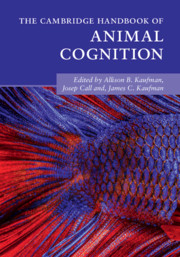Book contents
- The Cambridge Handbook of Animal Cognition
- The Cambridge Handbook of Animal Cognition
- Copyright page
- Dedication
- Contents
- Figures, Tables, and Boxes
- Contributors
- Acknowledgments
- Introduction
- Part I Communication and Language
- Part II Memory and Recall
- Part III Social Cognition
- Part IV Social Learning and Teaching
- Part V Numerical and Quantitative Abilities
- Part VI Innovation and Problem-Solving
- 28 Innovation and Problem-Solving Overview
- 29 General Intelligence (g) in Mice
- 30 Bowerbird Innovation and Problem-Solving
- 31 Parrot Innovation
- 32 Innovation in Marine Mammals
- 33 Innovation in Capuchin Monkeys
- 34 Innovation and Problem-Solving in Orangutans
- 35 Do Apes and Monkeys Know What They (Don’t) Know?
- 36 Decision Making in Animals
- Index
- References
33 - Innovation in Capuchin Monkeys
from Part VI - Innovation and Problem-Solving
Published online by Cambridge University Press: 01 July 2021
- The Cambridge Handbook of Animal Cognition
- The Cambridge Handbook of Animal Cognition
- Copyright page
- Dedication
- Contents
- Figures, Tables, and Boxes
- Contributors
- Acknowledgments
- Introduction
- Part I Communication and Language
- Part II Memory and Recall
- Part III Social Cognition
- Part IV Social Learning and Teaching
- Part V Numerical and Quantitative Abilities
- Part VI Innovation and Problem-Solving
- 28 Innovation and Problem-Solving Overview
- 29 General Intelligence (g) in Mice
- 30 Bowerbird Innovation and Problem-Solving
- 31 Parrot Innovation
- 32 Innovation in Marine Mammals
- 33 Innovation in Capuchin Monkeys
- 34 Innovation and Problem-Solving in Orangutans
- 35 Do Apes and Monkeys Know What They (Don’t) Know?
- 36 Decision Making in Animals
- Index
- References
Summary
Capuchins are highly encephalized New World monkeys (family Cebidae, subfamily Cebinae) living in a variety of forest and savannah habitats, from Central to South America, and currently classified as “gracile” (the Cebus genus) or “robust” (the Sapajus genus). The literature on behavioural plasticity in this taxon highlights purported traditions in the social domain (as the dyadic “games” of Cebus capucinus) and in foraging techniques (notably, the use of tools by Sapajus spp.). Behavioural innovations (sensu “process”) are more easily detected in the social realm, while technological traditions seem to result from [inferred] innovations (sensu “product”) facilitated by innate predispositions and environmental affordances and perpetuated by means of socially biased learning. Constraints related to simpler forms of social learning (like “stimulus enhancement”) may limit the potential for cumulative cultural processes, resulting in conservative traditions, as may be the case of percussive stone tools’ use. On the other hand, the degrees of “niche construction” and “observability” associated to different forms of tool use may explain the difference between the widespread stone tool use traditions and the rarer cases of customary probe use (where individual innovations may occur, but seldom spread by socially mediated learning), in terms of different opportunities for socially mediated learning.
- Type
- Chapter
- Information
- The Cambridge Handbook of Animal Cognition , pp. 721 - 732Publisher: Cambridge University PressPrint publication year: 2021



